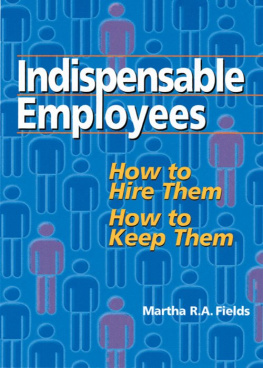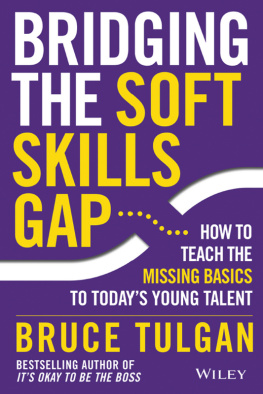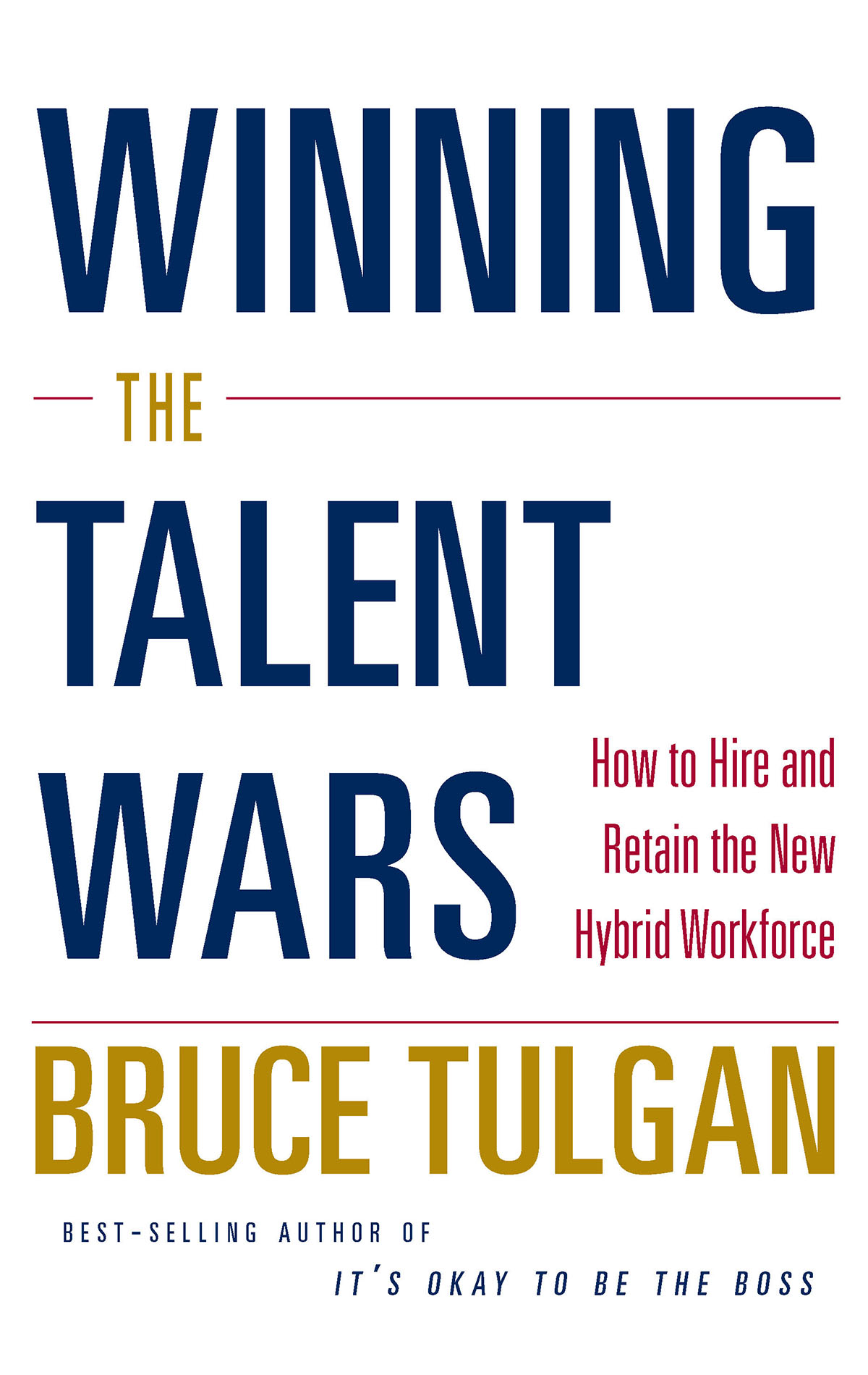Contents
Guide
Page List
WINNING
THE
TALENT
WARS
Bruce Tulgan

This book is dedicated to my wife,
Debby Applegate
CONTENTS
W ith all the fluctuations in the economy in this era of uncertainty, one business truth is not going to change: Talent is the number one asset of every organization in every industry. In good times and bad alike, leaders must get more work out of fewer people, and that means the best people are always in great demand. Nearly all projections indicate that, despite ups and downs in the unemployment rate, the supply of skilled talent will be outpaced by demand for the foreseeable future. Thats why the talent wars are not going to end.
Still, a lot has changed since this book was first released. The economy has gone from boom times to bust and back and forth, again and again. Layoffs reached record highs, then hiring did, then layoffs, and hiring; again and again.
The new labor marketfor the foreseeable futurewill be driven by the effects of highly interconnected, rapidly changing, fiercely competitive global markets. Business leaders must move resources quickly out of cooling-off market segments... and just as quickly move resources into market segments that are heating up. They must make and unmake new business combinations. They must cut waste and increase performance. They must implement new technologies to streamline operations and improve efficiency. And then do it again; and again and again.
Agility has replaced stability as the key to strategic advantage for organizations of all sizes in just about every industry. Why? Because organizations must be flexible enough to adjust quickly and smoothly to changing circumstances. Sometimes that means hiring like crazy to increase productive capacity. Just as often it means downsizing in droves. In fact, it is rather common for companies to hire substantial numbers of new employees at the same time the firm is downsizing. These changing circumstances have transformed the traditional employer-employee relationship. Long-term employment is increasingly rare, job security is a thing of the past, and employees no longer patiently pay their dues and wait to climb the organizational ladder. That transformation was a fundamental premise of this book when I first wrote it. The reality of it has been demonstrated now every which way from Sunday.
Ive been writing for decades now about the free agent mindset that has transformed the workforcethe idea that no matter where you work or what you do, you are ultimately in business for yourself and must vigorously fend for yourself. During economic booms, many observers assume that this mindset is just for disloyal job-hoppers and driven by super-tight labor markets. These observers convince themselves that free agency goes away each time the next recession comes along.
But each time downsizing returns to the front pages, we are reminded of the true origin of the free agent mindset: necessity. More and more employees think like free agents because they have no other choice. They cannot rely on established employers to secure their livelihoods. Individuals simply must take responsibility for their own careers.
In boom times, employees have the upper hand in the labor market. When the economy slows, employees lose negotiating power. Why? Its just the logic of the marketplacesupply and demand. This has always been true on a macro level. What is rather astonishing is market logic has taken over on the micro level as well. Seniority and hierarchy now take a backseat in employment relationships, as the day-to-day detailsassignments, schedules, work conditions, rewardsare subject to ongoing negotiations between managers and the employees they supervise.
This puts managers under incredible pressure because they are forced every day to balance the needs of employees with the interests of the organization. Senior executives are breathing down managers necks pushing for increased productivity and quality. That means managers must get more work and better work out of fewer people. So most employees find themselves hustling double-time nowadays, but they look to managers for guidance, training, motivation, feedback, and rewards.
It is the manager who is on the front lines, who must roll up her sleeves and get into the trenches every day: Keep the talent pipeline full and get the right people in the right places at the right times. Get new people up to speed quickly. Coach, cajole, bargain, inspire, motivate, and reward. Identify and develop the stars and draw them into the organizations core group. Retain the best, and eliminate the worst.
Thats why I wrote this book for real staffing professionals and managers scrambling to hire, manage, and retain amid perpetual staffing shortages. There is plenty of high-level business strategy throughout the book, but its the kind of strategy that any manager can use.
The philosophy is simple: Forget seniority. Forget hierarchy. Employment relationships are transactional by nature and they are increasingly governed by market logic. So you had better learn to manage people according to market principles. That means every term of employment is on the table all the time. Every employee has a chance to work harder, longer, smarter, faster, and better in exchange for a better deal. And every employment relationship has long-term potential, but every deal is short-term and every payoff is contingent on concrete deliverables. Flexibility and accountability go hand in hand.
This book is filled with concrete examples of the best practices in staffing, rewards, coaching, training, and retention. There are many stories from the most exuberant days of economic boom times, but those days are not the point of the book. The point is how to hire, manage, and retain people in this new era of uncertaintywhen markets are chaotic and resource needs are unpredictable.
In this high-speed, high-tech, knowledge-based, super-fluid economy, what are the best strategies and tactics for getting the best work out of the best people and retain them one day at a time? I hope youll find the answers in this book.
I was not surprised when the CEO of a multi-billion dollar health care giant invited me to his office at the corporate headquarters in for a chat. Thats what I do. Since the early 1990s, Ive spent hundreds of a year chatting with business leaders and managers about the single greatest challenge they face in the new economy: winning the talent wars.
It was way back then, circa 1997, in the heady days of my first talent wars. As I walked into the CEOs office, three of his senior executives followed me in. They all wore white shirts and dark suits. I was wearing a pair of gray pants, a black sports jacket, a blue shirt, and a red tie. Nobody said a word. We exchanged a few smiles. Then the CEO appeared in the doorway. He, too, wore a white shirt and a dark blue suit.
As we took up positions on the couches around a glass coffee table, the CEO looked at me and said, You know, my first day of work at here was a long time ago, but I still remember. I wore a blue shirt, and my manager sent me home to change. Umm... I asked, Do you want me to go home and change, sir? No, no, he said, I was just remembering.
Then the CEO began musing aloud about casual dress. It sounded like the headquarters personnel at this company wouldnt be dressing down anytime soon, but the dress code was being relaxed in many companies throughout the world. People in the operating companies tell me you have to offer casual dress now or nobody wants to work for you, he said. Im not going to stand in the way of that. Soon HQ followed suit, after all.






